#Nuclear-pulse propulsion
Text

A Captain sees her ship for the first time.
Some random art for: @temper-temper
#Art#Random Art#FairChild#temper-temper#My Little Pony#MLP#Pegasus#Space#Science Fiction#Spaceship#Project Orion#Orion Space Battleship#Nuclear-pulse propulsion#Wisconsin#Idk I thought you might like this haha#Also yes that is indeed 16 inch gun battery from the battleship Wisconsin being attached to the space battleship Wisconsin#Because why not?
24 notes
·
View notes
Text



19 notes
·
View notes
Text
"Even so, it was startling to hear the name Stanislaw Ulam come up on a streaming TV series. Somebody was doing their homework, as Freeman Dyson liked to say. Ulam’s name will always be associated with nuclear pulse propulsion (along with the Monte Carlo method of computation and many other key developments in nuclear physics). It was in 1955 that he and Cornelius Everett performed the first full mathematical treatment of what would become Orion, but the concept goes back as far as Ulam’s initial Los Alamos calculations in 1947."
"Familiar with this work, Johndale Solem took the next step. Solem worked at Los Alamos from 1969 to 2000, along the way authoring numerous scientific and technical papers. In the early 1990s, he discussed the design he called Medusa, noting in an internal report that his spacecraft would look something like a jellyfish as it moved through space."
The comments also have a healthy discussion about where the Staircase idea in the Netflix series originates from. There is also discussion between the American and Chinese versions of the 3 body problem.
0 notes
Text
Medusa-Class Battleship

Creator: Thai'Qul
Length: 798 Meters
Width: 378 Meters (Widest Point); 70 meters (Narrowest Point)
Propulsion: Nuclear Pulse Drive; Five Fusion Drive Thrusters
Crew Complement: 5,000-7,000 (Normal complement); 10,000 (Max. Capacity)
Radiator Type: Solid-State/Droplet
Armaments:
x8 40mm Point Defense Cannons (PDCs) (Aft)
x4 Cargo/Torpedo Bays (Aft)
x2000 5-kiloton driver warheads (Aft)
x4 Ultra-Relativistic Electron Beam (UREB) Cannons (Bow)
Interior
Because the Thai'Qul are an aquatic species, their ships are unique in being almost entirely filled with water. This pulls triple duty in protecting the occupants from intense G-forces, radiation and heat; providing resources for the fusion reactor and torpedoes, and in the event of a hull breach, lost water can be more easily retrieved than air. The consequence of this is that it increases the ship's overall mass, requiring more energy for any kind of acceleration or deceleration. This is also another reason for their ruthless pragmatism: the lack of air pockets outside the cargo sections prevents them from easily taking prisoners or taking larger ships aboard.
Creators
An average Thai'Qul male. Roughly 85% of the species is male, carrying out tasks for the rarely-seen matriarchs, who outsize them significantly. On ships such as the Medusa-class, prepubescent matriarchs- referred to colloquially as "Countesses"- serve the role of captains and admirals.
Strategic Overview
If there's any way to describe the Thai'Qul military doctrine, it would be ruthless pragmatism. Rather than engaging in widespread power projection, heavier ships are mostly concentrated within their own systems, while smaller vessels are the most commonly encountered. These represent the first line of defense, focused on patrolling defense perimeters.
Should a perimeter be broken and an enemy force infiltrate a Thai'Qul system, either by evading or destroying lighter vessels, this is when battleships such as the Medusa-class are deployed. This typically follows barrages of Thai'Qul frigates and corvettes, which will try to guide invaders into designated kill zones, where the Medusa-class will engage them at close range, such as near large asteroids, space stations or ring systems.
While these battleships lack high speed or fine maneuvering, they make up for it with powerful defenses and overwhelming firepower, particularly their UREBs. Once the invader's shields and other defenses have been exhausted, should they refuse to surrender, attacks from these beams will irradiate and effectively sterilize the target.
This is done because, rather than simply blowing up bellicose ships, the Thai'Qul will always try to salvage as much technology and information from them as possible, either to assess motivations or reverse-engineer whatever they discover. Of course, should a ship surrender instead, the Thai'Qul will gladly accept, taking the time to analyze captured ships just as thoroughly.
This doctrine has proven to be quite effective in multiple engagements and ensured invasions of their systems are rare.
Ship Diagram
The Bow Shield is a large dome entirely covered in ablative heat-resistant armor.
The nose of the craft houses the four UREB cannons, which cover a large hemispherical field. While the beams lose effectiveness over time or when fired at an angle, time dilation effects prevent them from completely dissipating over longer ranges. Maximum energy from the bremsstrahlung resulting from impact has been measured at over 5,000 Sieverts.
The UREBs are only possible via the battleship's length, where the linear accelerator (Linac) runs along the central axis of the ship.
The Medusa-Class doesn't have a designated bridge or command module, but instead 36 large windowless spheres, where most of the crew resides. Commands, controls and sensor readings are instead performed using holographic display interfaces that crew members can pull up at any moment. This ensures damage to one area of the ship will not compromise control, and that key staff can be moved into the interior.
The ship uses a combination of solid-state and droplet cooling with liquid lithium, firing the molten coolant into space, where it condenses into larger drops before being recaptured in a dish section for recirculation. Additional radiators vent excess heat to prevent the lithium from completely vaporizing. In times of duress, this coolant can be used as everything from makeshift flares to additional thrusters.
The aft section consists of a large octagonal cylinder, which houses bay sections designed to be drained of water so cargo, torpedoes and other craft can be sent into space. This is also where the ship's fusion reactor is housed.
The PDCs, nicknamed "Barnacles," allow the ship to fire at targets behind or beside the ship.
Contrary to popular belief, the piston supports are only painted blue and not transparent, though they are full of water to help cushion the impact following a pulse.
The pistons and their shock absorbers are attached to a set of electric motors, which extract a small, but not insubstantial amount of power from every pulse.
The Drive Cone is fitted with flexible rings and is even colored bright white to take advantage of as much radiation pressure as possible. Usage of this drive is why the battleship can't be used in a planetary orbit, as the risk of creating radiation belts poses a threat to orbital infrastructure.
#the-helixverse#ekpyrosis#thai'qul#spaceship#worldbuilding#my art#hard science fiction#hard sci fi#ship design#project orion#worldbuilding art#scifi art
22 notes
·
View notes
Text
Interstellar travel has been accomplished in a variety of ways by the species we have encountered so far. Several species have managed to circumvent the fundamental problem of time involved in traversing vast distances by simply brute forcing it--typically, technologically-aided hibernation techniques, or unbounded lifespans. But both require quite a bit of luck, evolutionarily speaking, so this approach is rare. The Titawinese originally used artificial minds to control their ships, and generation ships or frozen embryos for colonization. The Chalawani relied on nuclear pulse propulsion for exploring their immediate surroundings, as we did for intra-system travel; but as starships these drives have a very limited range, and are still comparatively slow. The Inquillans used sublight ships powered by antimatter--their designs were technological marvels, but the fuel was extremely expensive to produce. The Mazaalai linked their five systems together through laser-driven lightsailers, though it took generations to build the infrastructure that supported it.
I cannot quite communicate the astonishment we felt when we encountered the first of your ships. A survey satellite in a polar orbit over Dimidium detected an unusual burst of cosmic rays from just over the planet's limb. Then hours later, another, slightly brighter. Then not long after that another, brighter still. This was, of course, the survey ship Zakynthos closing on the artificial radio source it detected, but from the readout alone it looked like the world's most improbable series of gamma-ray bursts, or a freak malfunction. We diverted the nearest torchship to investigate. It found, not a gamma-ray burst or a malfunction, but a ship--a small ship, with seven strange aliens aboard, of a configuration we had never seen. And these aliens claimed, against all common sense, that their ship was not only from a star system twenty-seven light years away, but that they had made that journey in a matter of weeks. At that point we were more ready to accept that we had somehow overlooked an entire spacefaring species on one of our core planets, than that these bizarre creatures had a real, working FTL drive.
That these aliens proved not to be the inheritors of some impossibly wise ancient civilization--that, in fact, they were from a species that had left its home system for the first time not one hundred years before, seized by an inexplicable desire to brave the hazards of space and to befriend any strange creatures they might come across--was a source of the most intense consternation. We felt--we still often feel, forgive us--that you are an impossibly naive culture. Naturally, we immediately accepted your offer of friendship. In no small part, I think, because you remind us of what we once were, and might someday hope to be again: hopeful explorers, awed by the limitless possibilities of the universe. But we also felt a sense of obligation. Someone has to keep you all from getting yourselves killed.
--Helvetosian ambassador to Earth, on the occasion of the 25th anniversary of first contact
107 notes
·
View notes
Note
is it me or does that ship/cannon/whatever it is have a lot of balls?
//Yep! And there's a good reason for that
//I explain it in detail here ^^
3 notes
·
View notes
Text
The Melee Run, Cogmind Beta 13
This is my third run of B13 :3 My goal was to destroy a RIF Installer and get an ECA so I can summon Warlord's friends to help me out.
Let's go!
-9 Mats
Picked up a system shield and improved visual processing unit.
-9 Mines
-8 Mats
Picked up corrupted proto shotgun and gained 5% corruption :(
Picked up corrupted proto autogun and gained 3% corruption :((
Confirmed no branch access is available, so we're going to -7. Couldn't find a garrison. Got a maul and katana with melee analysis! Considering treads and EM cannons since I found a lot of coolant utils.
-7 Factory
-7 Garrison
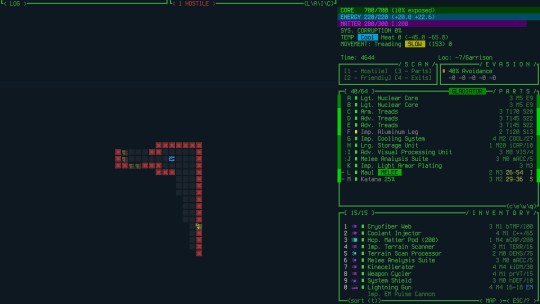
Acquired advanced melee analysis. Intentionally destroyed RIF installer. Acquired nanoactuators, hardcell cannon, improved fusion compressor, and light antimatter reactor. Ran from a behemoth. Looped back to -7.
-7 Factory
Worried about propulsion. Lost propulsion and move time rose to 240 which is way too high, so I must respec. Found cesium-ion thruster, guess we're flight melee now!
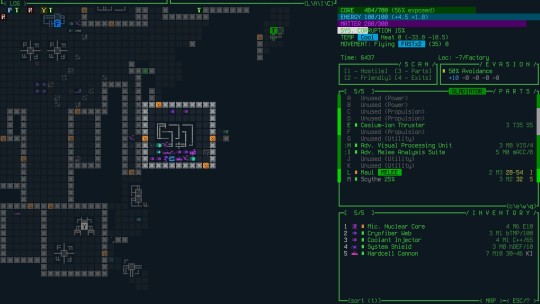
-7 Lower Caves
Cesium-ion thruster immediately destroyed, picked up VTOL module. Core at 129 durability has me worried. ZB-3UA(g) tells me about Warlord and gives me the ECA! Yay!

-7 more Caves?
Get me outta here.
-6 Factory
All melee weapons destroyed, but managed to get a couple flails soon after. Got a Xenon bombardment thruster.
-5 Factory
Got field propulsion drive. I was picking up some treads but I think I'll stick with flight, it feels really good! Dropped treads. Found enhanced optical array. Found 2x cooled Cesium-ion thruster in a transport!
-4 Factory

Lost all power sources. Found a light neutrino core! Now using two improved melee analysis suites and two advanced melee analysis suites. Lost light neutrino core but found a fusion compressor, which demands 1 matter per turn and that's not ideal.
-3 Research
Swapped out fusion compressor for a cold fusion core and picked up some impulse thrusters. Got beat up but found 3 impulse thruster arrays, advanced RCS, and a couple of shock mauls! Dropped ECA for nuclear pulse array, since I've not done enough damage to get Warlord's help. There were so many Titans and even cutters surrounded me. I thought for sure the run would end there, but I bravely fought the cutters and only lost power sources and shock mauls thanks to my advanced utility shield I picked up. I swapped out the shield for a heavier power source and force lance soon after since it was quite beat up. I fly and I fly fast with my new impulse thruster arrays.
-2 Research
I now equip 3 impulse thruster arrays at the same time since they are large in my 5 slot inventory. Maybe I'll get lucky and find some more utility shielding or even light armor. Reached a peak rating of over 100 when I picked up advanced RCS! Picked up a proto flight unit while running from an ARC squad of grunts, and it was a faulty electron diverter, which triggered a power surge that broke my second-to-last impulse thruster array. Very unlucky!

I got the hunted achievement to simultaneously be tracked by 20 hostiles just after i found a lucky restock of 4 impulse thruster arrays. But my last hacking util got destroyed so now I'm wondering how I can escape from -1 Access. Maybe I can destroy the access shield with my half durability shock maul? I doubt that the melee weapon will even last me long enough to find the exit.

-1 Access
I now equip 4 impulse thruster arrays, a light quantum reactor, and a shock maul. My inventory has only a cooled field propulsion drive. I have no utility. How am I supposed to escape with this? I hope I find some hackwear I guess… I just wish I had my visual processing unit :( I did just find a basic ECM suite though. That will help! I lost 3 of my 4 impulse thruster arrays to swarmers so I equip my last prop on hand, the cooled field propulsion drive. OwO I just found a hacking suite! That's going in the inventory for safekeeping until I find the exit. I found a field propulsion array but I'm terribly worried about losing my last power source. I'm still being chased by the swarmers :( Got triple warning now: core, energy, matter. Not looking too good!
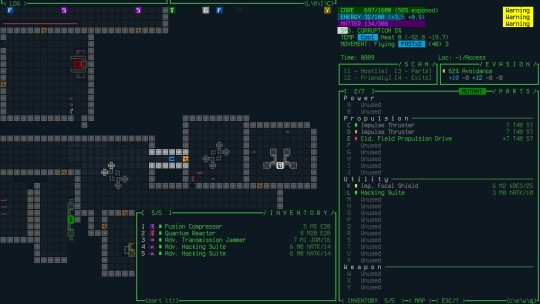
Everything has been destroyed. I am a naked core with two advanced hacking suites in my inventory uwu

Alert: core integrity low. I found an experimental melee analysis suite, which would be great except I haven't had any melee weapons in a little while now >w< they got shot. I ran into a heavy, another group of swarmers, and a programmer while running from cutters and… core destroyed. I must have been SO close to the exit. SO close.
Final score:
13921
New PB! Yay!
Check me out on the scoreboard under the name Lazuli (give it a day to update, I just finished this run!) :3
I should have just installed RIF! At the time of destroying it, I was still leaning towards abandoning melee and instead committing to a heavy cannon build since I had so much heat dissipation potential. I was going to switch to a tank build once I got the ECA but I just wanted a good utility to detect bots and scan for rooms. I got beat up pretty bad in the Factory -7 level between destroying RIF and entering the Lower Caves so my hand was forced.
If I had just installed RIF and gone for couplings, then I think I would have won the game with the melee flight build. Lesson learned for next time: if you want ECA, you need to clear garrisons and DSFs. Running isn't helpful for ECA and whenever I tried on the ECA, it would complain that I have a D-approval rating with Warlord :(
Next time I will just install the RIF and fly to victory!
0 notes
Link
Researchers consistently complain about how difficult it is to fund breakthrough research. Most funding agencies, especially governmental ones, think funding incremental, evolutionary technological steps is the way to go, as it has the most significant immediate payback. But longer-term, higher-risk research is necessary to provide those incremental steps 20-30 years in the future. And in some cases, they are required to underpin completely new things that other researchers want to do.That is the case with space propulsion systems. Current mature technologies, mainly derived from chemical rockets, cannot provide the necessary force to allow for a gravitational lens telescope out in the Oort cloud, an interstellar probe, or a round trip to Mars that would take less than a year. But other technologies on the horizon could if only we spent more time and resources developing them. So a group of NASA and DoE engineers recently released a paper detailing some of those and where they think America’s space agency should direct its funding when developing new propulsion systems.At the beginning of the paper, the authors lament that there hasn’t been any large-scale NASA investment in breakthrough propulsion technologies since the 1970s. And they’re right; the last significant effort was the Nuclear Engine for Rocket Vehicle Application (NERVA) project, which wound down in the 1970s. Despite the lack of prototyping, plenty of ideas were put forward then. Just none have made them into hardware.Novel propulsion systems are always fun to talk about – as Fraser proves int his interview.Those ideas can be broadly categorized into four different groups of systems: chemical propulsion, nuclear thermal propulsion, solar electric propulsion (SEP), and nuclear electric propulsion (NEP). The rest of the study aimed to determine what if any, significant advancements could be made in those four systems that could lead to them lowering the round-trip time to Mars to less than one year.The authors discard chemical propulsion and nuclear thermal propulsion, stating that they are simply not cut out for the rapid technological changes that could enable their use for these game-changing propulsion systems. Chemical propulsion suffers from “the tyranny of the rocket equation,” as Isaac Arthur puts it. But nuclear thermal propulsion suffers from the same underlying problem – they must carry too much weight in propellants to be viable for truly ground-breaking speed increases.That leaves solar electric propulsion and nuclear electric propulsion. The authors break down the current state-of-the-art technologies for each technology and calculate the weight per kilowatt of energy they produce. Neither looks particularly promising at the state of the art – with NEP coming in at 51 kg/kWe and various solar arrays that could drive a SEP system ranging from 5 kg/kWe up to 22.73 kWe. None of those weight/power tradeoffs would result in anything approaching a sub-one-year time to Mars.Ion engines could potentially be scaled to the point where we could get to Mars quickly – if we fund them enough.But why stop there? The authors do a deep dive into potential technologies on the horizon, ranging from materials to photovoltaics, that could dramatically impact those calculated ratios. The paper concludes with “transformative” technologies that could decrease the kg/kWe to below one. In that case, an extensive enough power system can reasonably transport humans to Mars in between 50 and 100 days. The researchers also looked at some early-stage propulsion concepts from NASA’s Institute for Advanced Concepts – including the ever-popular “pulsed nuclear” propulsion system, where a nuclear explosion is intentionally initiated behind the spacecraft to push it forward. These technologies are too early to be included in a deep-dive analysis, but they could lead to some promising alternative technologies.To invest in those alternative technologies, the authors suggest NASA commit 1% of its Space Nuclear Propulsion budget to developing breakthrough technologies. At $45 million for FY2023, the whole budget isn’t exactly breaking the bank, and a mere $450,000 probably wouldn’t make too big of waves in the industry. But, it is undoubtedly better than what is currently allotted toward maturing these transformative propulsion technologies.Learn More:Dankanich et al. – Transformational Propulsion for In-Space Fast TransitsUT – Solar Electric Propulsion Systems are Just What we Need for Efficient Trips to MarsUT – A Novel Propulsion System Would Hurl Hypervelocity Pellets at a Spacecraft to Speed it upUT – Magnetic Fusion Plasma Engines Could Carry us Across the Solar System and Into Interstellar SpaceLead Image:Mars/Lunar Transfer OrbitsCredit – Dankanich et al.The post What Future Propulsion Technologies Should NASA Invest In? appeared first on Universe Today.
0 notes
Text
9. Electromagnetic reload projectile



China's submarine capability and strategy nuclear propulsion, evolving submarine detection technologies and rail gun development, intensify research into power, pulse, heat involved in launching projectiles while the US ceased its funding of research in 2021 citing integration challenges with hypersonic capabilities and barrel design materials which can melt. The Chinese have also found a way to use liquid metal to reduce wear and tear on the weaponry.
All this on a Friday, late September two thousand and twenty-three years like a bum on a balogna sandwich...
#ongoingsagafromspace#musebunker#the matrix#creative#doom'd#my comicbook story#narrative blank#we're here#comic book story#micropoetry#freedom
0 notes
Text
How Many ISPs to Travel Interstellar?
I watched The Angry Astronaut Discussing Interstellar Travel and he was saying that we already have engines that can be used for that in the video. He points out the possibility of using nuclear pulse propulsion with the Orion Starship, I don’t think nuclear engines have the ISPs to travel interstellar.
Nuclear Electric Ion Engines were being tested in 1964, but it took too long to reach ideal…

View On WordPress
0 notes
Text

Meanwhile:

Yea, the 60s was a crazy time when it came to space technology.
#Art#Random Art#Space#Project Orion#Nuclear-pulse propulsion#Seriously this was a thing#They actually considered the idea of spaceships powered by nuclear bombs#It was crazy#Yet fascinating at the same time#Anyways#I'm at work its a slow day and am bored
14 notes
·
View notes
Text
Wisdom is neither inheritance nor a legacy
1. UPPITY NUCLEAR PULSE PROPULSION
2. INTUITIVE NUCLEAR PULSE PROPULSION
3. SUBORDINATE NUCLEAR PULSE PROPULSION
4. TWISTED NUCLEAR PULSE PROPULSION
5. CONFINING NUCLEAR PULSE PROPULSION
6. NUANCED NUCLEAR PULSE PROPULSION
7. APPROACHABLE NUCLEAR PULSE PROPULSION
8. SWOONING NUCLEAR PULSE PROPULSION
9. CORONARY NUCLEAR PULSE PROPULSION
10. SUFFERING NUCLEAR PULSE PROPULSION
11. ALTRUISTIC NUCLEAR PULSE PROPULSION
12. INTERSECTING NUCLEAR PULSE PROPULSION
13. PULLED NUCLEAR PULSE PROPULSION
14. BLUECOLLAR NUCLEAR PULSE PROPULSION
15. LESSENING NUCLEAR PULSE PROPULSION
16. PROTRACTED NUCLEAR PULSE PROPULSION
17. INCOMPREHENSIBLE NUCLEAR PULSE PROPULSION
18. MISSHAPEN NUCLEAR PULSE PROPULSION
19. SPANKING NUCLEAR PULSE PROPULSION
0 notes
Photo
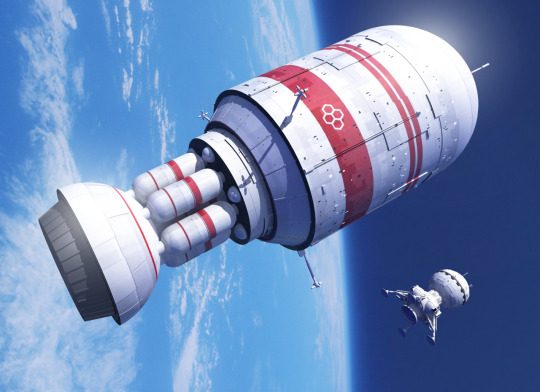
“Nuclear Pulse Starship” by Paul Lloyd.
111 notes
·
View notes
Text
Project Dandelion
So generation ships. It’s been a few years, but I’ve brought them up before. My basic thought for an interstellar settlement effort is this: don’t send a completed city or ship, send a small seed ship along with the tools and raw materials to bootstrap itself into a thriving city that arrives at its destination just as it’s running out of space and materials for growth.
Something that might look like this in it’s various stages:
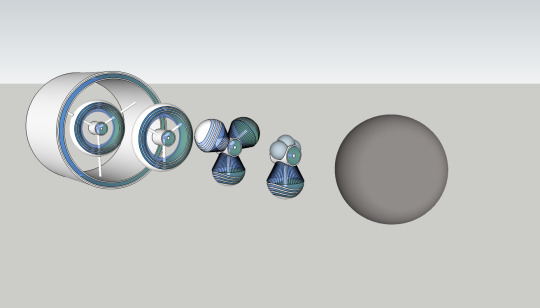
The grey sphere represents the ore-pile sent with the original ship, and the four ships show the growing colony as it expands from 200 people to 500 to 1000 to 10,000 just in time to arrive at one of the nearest stars. The ore pile doubles as micro-meteorite shielding in the direction of travel, which for a habitat traveling at percentage levels of light-speed is somewhat more critical than might otherwise be the case.
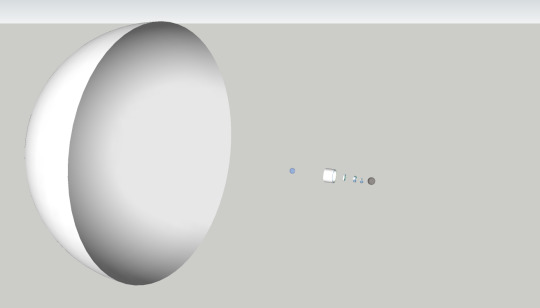
The hemisphere shows the parachute for a medusa style nuclear pulse rocket used to brake the ship at its destination, and the little blue sphere shows the final colony collapsed for deceleration, into a form where it can serve as the initial hab in a bolo-style station that will be the start of a much larger city in it’s new solar system.
The nice thing about this general idea for an interstellar spaceship is that aside from the engine itself, and the impossibility of immigration or emigration, the basic model of running and growing the city itself is identical to that of how most of the stations I draw would be built and expanded over time. So, ideally, by the time someone decides to take their city to another solar system humanity will already have experience on building, expanding, maintaining, and upgrading multi-decade or even multi-century habitat projects.
The other thing to consider is the 200-10,000 population range and the size of the ore pile is built around a 2-400 year trip using nuclear pulse propulsion with a large enough reserve of uranium at the far end to actually decelerate the thing. That’s probably somewhere between realistic to optimistic for the initial trip. Barring fundamental changes in physics, the rocket equation is cruel. On the other hand, once the initial trip has been made you can build the infrastructure to use laser-pumped solar sails for both the start and the stop parts of the trip and cut the mass of the ship (and hopefully the travel time) way down.
5 notes
·
View notes
Text
SMS Kammerjäger
Key/Definitions
*(NUMBER x NUMBER) 1st number is number of gunpods (turrets), 2nd number is how many guns per turret.
______
*(NUMBERx) total amount of guns
______
*(Belt armour)
Belt armour is the main side armor on a warship.
Diagram of common elements of warship armor. The belt armor is on the exterior, at the waterline. Also indicated is the main deck, the sloping deck armor, and the torpedo bulkhead
______
*(Armored citadel)
An armoured citadel is an armoured box enclosing the machinery and magazine spaces, formed by the armoured deck, the waterline belt, and the transverse bulkheads.
______
*(Sloped armour)
Simply sloping a piece of armour inherently increases its effectiveness by increasing the distance a projectile must travel to penetrate it. It also increases the odds that a projectile will ricochet off the target without causing damage.
*(Torpedo bulkhead)
A torpedo bulkhead is common on the more heavily armoured warships, especially battleships and battlecruisers of the early 20th century. It is designed to keep the ship afloat even if the hull was struck underneath the belt armour by a shell or by a torpedo.
After the lessons learned during World War I, many capital ships were refitted with double, triple, or even quadruple torpedo bulkheads, as well as anti-torpedo bulges to the exterior of the hull. For example, the last US battleship designs during World War II had up to four torpedo bulkheads and a triple-bottom. The innermost bulkhead is commonly referred to as the holding bulkhead, and often this bulkhead would be manufactured from high tensile steel that could deform and absorb the pressure pulse from a torpedo hit without breaking. If the final bulkhead was at least 37 mm thick, it may also be referred to as an armoured bulkhead, as it would be capable of stopping splinters and shells with low striking velocities.
______________________________________________________________
SMS Kammerjäger
Class: Kammerjager (exterminator)
_____
Place of origin: Terra, Germany
_____
Armament:
(1x) Weltuntergangsprophet 230cm (90 in) SK/38 Cannon
(88x) 112cm (44in) SK C/6 Naval gun (44 x 2)
(44x) 38cm (15in) SK C/34 Naval gun (12 x 4)
(112x) 10mm SRAAL (Short Range Anti Air Laser)
(92x) 20mm LRAAL (Long Range Anti Air Laser)
(356x) 2 cm Flakvierling 38
_____
1420mm Depleted uranium belt armour
1000mm Hull armour
Sextuple torpedo bulkheads
Krupp homogeneous depleted uranium lead lined citadel
1900mm underbelly plating
300mm harshly angled steel add on side Armour
1730mm upper deck plating
______
Length: 3,263 ft 6in long
______
Beam: 600 ft 6in
______
Draft: 100ft 6 in
______
Installed power: Supersized Nuclear cold star absorbing reactors (feeds on intense radiation waves of all kinds, and the dead cores of planets)
______
Propulsion: Krupp cold star propulsion jets (14x)
______
Speed: 26 knots (29 mph)
______
Crew complement: 6,530 total, 312 officers, 6,218 enlisted men and women.
______
General description:
The deadliest ship in the galaxy. She is the only one of her class, no other ship in the current universe could ever hope to match her armor or firepower. Her armor is impenetrable to any form of kinetic weaponry, and in testing, a 3,000 trillion watt hyper focused beam took 8 hours to even make a dent in the side armor, and a whole day to finally melt through and eventually breach the inside. She withstood crushing depths deeper than the human location of “challenger deep” for a whole day on the planet “alpha 4546b”, before testers eventually gave up and raised her.
Her mighty guns go through all but the thickest armour, Her HE shell blasting straight through a Xyr flagship class dreadnought. Not a single thing stood in the way of this mechanical nightmare.
The centerpiece of this beast is a mighty cannon, mounted in front of the superstructure. The total diameter of the bore of the gun is 230cm, or 90 inches. The gun can’t use anything other than HE, as the experimental APHE tore the test hull in half from the sheer muzzle velocity of the projectile.
The armour is blasted black in almost every area, save for a few select spots. The appearance is that of a supersized Ungetum class dreadnought, with harshly angled side armor, and a massive black steel human skull with tentacles crawling out of its eyes and mouth sits at the head of the ship as a figurehead.
_____________________________
Alright I’m done, I’m not a professional writer, please bear that in mind, describing things in huge detail is really fucken hard with adhd, please leave constructive criticism in the replys.
As always kamerades, thank you for reading, have a good one.
#humans are crazy#humans are space orcs#humans are space oddities#humans are insane#dreadnought#this thing would suck absolute ass IRL
29 notes
·
View notes
Text
The competing early medieval Rocket Jesus Theory was condemned as heresy at the First Lateran Council in 1123, based on the fact that the original account of the Ascension in Luke-Acts makes no mention of Jesus possessing external fuel tanks or booster rockets, and that the interpretation of a “passing cloud” as referring to an exhaust trail is dubious. Some theologians advanced the possibility that Jesus might have been powered by a nuclear pulse propulsion engine, but given the lack of historical references to Jerusalem being obliterated by a series of nuclear explosions in 30 AD, this theory, too, was discarded.
53 notes
·
View notes